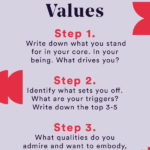If you value family but work 70 hours a week, are you in alignment with your values? What if your partner does not value family? How will you make it work where one does not harbor resentment over the other?
Do you know what makes you tick, and what ticks you off? How about the other person in the relationship?
Ah, clarity. There are a lot of assumptions when we enter into a relationship. We usually—subconsciously—let our social niceties, context, economic constraints, and status guide us. There’s a lot left unsaid and left to “chemistry” and being in the “flow” when we work with people. We usually figure out as we go, voicing our likes and dislikes and picking up on unsaid queues throughout each interaction. But are you on the same page, really?
In business partnerships, it’s especially important to know and share both your value set AND expected roles and responsibilities with all parties involved. Exercises like these help alleviate assumptions and highlight expectations for everyone. This helps you avoid double work, wasted energy, fights, frustration, hurt feelings and avoid one of the biggest pitfalls of business: blind spots.
A value set framework is a powerful tool for decision making. This is not a branding exercise. This is a leadership tool for you to stay true to yourself and who you are at your core, even when things get messy and overwhelming (and they will!)
Death by a 1,000 Cuts
Some of life’s decisions are really about determining what you value most. When many options seem reasonable, it’s helpful and comforting to rely on your values. When you’re working with other strong, but differing opinions, it’s important to know what you’re willing to sway on and what you’ll hold steadfast and strong to protect.
When we move away from our core value set to accommodate someone else, it initially feels like a papercut. Sharp and noticeable, but no one really got hurt. By the time you hit 1,000 of these, you’ll feel like you’re bleeding out and like you lost your way somewhere.
Establishing your own personal guidelines can help you stay healthy mentally and emotionally because you are your greatest asset. Period.
“Your beliefs become your thoughts. Your thoughts become your words. Your words become your actions. Your actions become your habits. Your habits become your values. Your values become your destiny.” –Ghandi

Creating, and Articulating your North Star Value Set
You are unique in your make-up and your upbringing. You might have cultural experiences that have defined how you handle confrontation and conflict. As a woman, you are most likely an empath. Women have learned to acquiesce and defer as part of social politeness. It’s an expensive habit we have to unlearn and reframe. If we ignore our value set and our true internal compass, it can lead to suppressed frustrations that come spilling out—usually at the most inopportune times because we’re redlining with lack of sleep, chronic stress, and an emotional hot button that keeps getting pushed. It’s how women often get labeled as “emotional” or “irrational.” Founded or unfounded, let’s not go there, shall we?
This is an exercise for you to know yourself better. It’s not a requirement to share, however when all parties at the table are transparent, it adds a significant understanding of how the working style could be arranged.
STEP 1
Write down what you stand for in your core. In your being. What drives you?
- Boil this down to 3-5 words
- Examples: Honesty, Connection, Collaboration, Enlightenment
- For each word ask “why” as if you were a two-year-old on a truth expedition. You’re going to drill down on the “why” quite a few times. Once you feel you cannot go any further with your “why” questioning, ask “what do I believe?”
EXAMPLE:
- Honesty.
- Why? I detest when someone lies.
- Why? I believe most people have an agenda.
- Why? I saw it happen to my parents and it’s been true my whole life after that.
- What do I believe? People should be honest and transparent in their needs and wants with each other.
- Why? I saw it happen to my parents and it’s been true my whole life after that.
- Why? I believe most people have an agenda.
- Why? I detest when someone lies.
- Connection.
- Why? We are all energetic beings and need connection.
- Why? Because we’re all the same. The differences are invented and imagined to suppress.
- What do I believe? When we connect we see someone for who they really are, not a stereotype.
- Why? Because we’re all the same. The differences are invented and imagined to suppress.
- Why? We are all energetic beings and need connection.
So, how do we use our values Honesty and Connection then?
Say you’re setting up a new business model and it’s suggested that you create a hierarchy and class divide with your price points. Is this in-line with your North Star? Does it serve your core value of Connection? Now, let’s look at the other values.
What if you use transparency and honesty about why you’re offering the new tiers? Is it to serve a smaller segment better? Is it to offer a lower price-point to reach a greater audience? If you told your customers clearly and plainly, is that within your core value of Honesty? If none of those are true and it’s just to serve a business model, how do you really feel about it?
STEP 2
Identify what sets you off. What are your triggers? Write down the top 3-5
- Examples: Being talked over. Someone re-doing your work. Someone not doing their portion of the work. The seat left up in the toilet.
Now, write what the commonality or theme is here. Is it being disrespected? Take a look and identify what it all boils down to for you. This is how you become aware of your watch-outs. It’s also a good idea to share with your partners what your triggers are so that everyone can work around them. Come up with a code word you wouldn’t normally use in a business setting, like “squirrel.” Whenever you’re feeling triggered, yell out “squirrel!” and let everyone take a breath.
STEP 3
What qualities do you admire and want to embody, but have not fully mastered yet?
- Examples: Leadership, listening, patience, confidence, etc.
Next, write HOW you will obtain those qualities. Is it a mentor, networking, joining a professional group, classes, seminars? Your brain is a very powerful problem-solving machine. Once you set out a task it will look for the shortest ways to obtain that goal.
STEP 4
List out your biggest fears.
-
- Examples: Failure, looking stupid, getting called out, etc.
- Examples: Failure, looking stupid, getting called out, etc.
I love this one because we often are afraid to tell another person our fears, but they already know our fears just by hanging out with us. They see each one like a Christmas tree ornament hanging and sparkling for all to see, and yet we’re totally blind to them. We imagine that if we don’t admit them, no one can see them.
Get comfortable with your fears. Write them down. Look them in the face, one by one. Your two new acronyms for life are:
FEAR: Face Everything and Rise
FAIL: First Attempt in Learning
Bonus Step
As a business and health coach, I also find for leaders it’s important to get over the inevitable feeling of imposter syndrome. A helpful companion exercise is to make three columns and write your accomplishments, how they made you feel, and how you obtained them in the first place.
For example:
- Graduating college
- Made me feel successful, full of pride for myself and my family
- Determination, dedication, being smart
What you learn from this list is actually how much you’ve accomplished in life. It’s more meaningful than you might give yourself credit for. You also can pinpoint the feeling when accomplishing your goals and celebrate yourself. That becomes important as you create new goals for yourself and business.
Lastly, this is the most important one – you identify what it took to obtain that goal. So, next time you start a litany of self-beat up for a small slip up, you can open your notebook and reflect, “Just how did I graduate? Right–I was determined, dedicated, and smart.”
Creating Lasting Progress
Trust when I say the North Star and Roles and Responsibilities (more on that here) exercises should be non-negotiable. You’ll find these may be the most important practices in creating a beautiful, healthy company and culture. As your definition of success changes, so do your personal values. Your values may adjust and develop over time just as you do, so embrace the change.
Lasting progress in any area takes time, but the effort will be worth it. When you apply these strategies to your own life and start #winning at this work-partnership thing, the immediate and lasting benefits of prioritizing your values will be hard to dispute.
…
Next up are the Roles and Responsibilities for you, your partners, investors, employees, and vendors. While it’s essential to pinpoint and articulate your values so that you don’t deviate from them, it’s just as important for you to share what your expectations on who does what, when, and who gets notified under which circumstances. Let’s get started!























